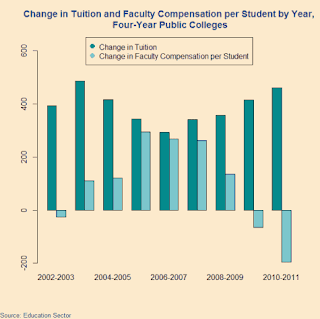But this can only explains the case of community colleges.
Baumol disease problem in higher education. It doesn't fully explain why college tuition is rising so much.
Now that there are many more PhDs, especially in the humanities, than tenure-track spots for them, the salaries of instructors are actually falling as universities turn to adjuncts. That directly contradicts the Baumol explanation.
Robert Martin at Centre College did a research showing that between 1987 and 2008, full professor salaries increased by an average of 0.9 percent a year, and assistant professor salaries by a measly 0.7 percent a year. But support staff salaries grew at more than double that rate. If the core act of teaching is driving costs higher, that just shouldn't be happening.
A more plausible theory might be Bowen theory: universities will spend all the money they can possibly raise. If they raise more than they need for educational objectives, they will spend it on non-educational uses like climbing walls and nicer buildings.
Revenue theory of cost:
"
1. "The dominant goals of institutions are educational excellence, prestige, and influence."
2. "There is virtually no limit to the amount of money an institution could spend for seemingly fruitful educational ends."
3. "Each institution raises all the money it can."
4. "Each institution spends all it raises."
5. "The cumulative effect of the preceding four laws is toward ever increasing expenditure."
For details, read the paper by Ronald Martin and R. Carter Hill.

No comments:
Post a Comment